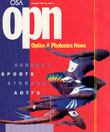
November 1997 Issue
Feature Articles
Lasers in Healthcare: Focus on Corneal Refractive Surgery
Refractive surgery techniques allow people with vision defects to see without the use of external aids. The authors provide a comprehensive picture of state-of-the-art, corneal surgery.
by M.N. Ediger and A.J. DurkinAcousto-Optic Tunable Filters
Acousto-optic tunable filters are powerful tools for spectroscopy, imaging, and WDM. Gupta traces the development of these devices and discusses current and future applications.
by Neelam GuptaElectro-Optical and Laser Technologies: Playing a Vital Role in Athletic Competition
ON YOUR MARK. GET SET. GO! TAKE A LOOK AT SOME NOVEL USES OF ELECTRO-OPTIC DEVICES.
by Manuel J. RodriguezOptical Data Storage: Three Perspectives
Milster has pulled together a series of articles that explore the status, potential, and future of three viable optical data storage systems.
by Demetri Psaltis, Douglas G. Stinson,and G.S. Kino, Tom D. MilsterHolographic Memories
Holographic memories, first investigated in the late- 1960s and early-70s, have made a remarkable comeback in the 1990s. Research in academia and industry (primarily in the U.S.) has resulted in a number of impressive laboratory demonstrations, showing that holographic memories have the storage density, readout speed, and fidelity required for competitive commercial products.
by Demetri Psaltis, Douglas G. Stinson,and G.S. Kino, Tom D. MilsterCompact Discs
With an installed base of over 100 million CD read-only memory (CD-ROM) readers and over half a billion CD audio players, the CD is easily the most successful family of optical storage systems, and in fact, one of the most successful consumer electronic products of all time. Approximately 90% of all personal computers shipped today contain a CD-ROM reader. This large installed base, plus the low cost of the disc ($.005/MB for a "one-off" recorded CD, less for a mass replicated CD) makes CD the ideal format for distributing or sharing digital data.
by Demetri Psaltis, Douglas G. Stinson,and G.S. Kino, Tom D. MilsterNear-Field Optical Storage
One disadvantage of CD-like systems is that the lens used to focus laser light onto the recording layer must be located some distance from the disc due to the presence of the protective substrate. Systems that do not have a protective substrate can use lens systems that are essentially in contact with the recording layer. This type of system is called a near-field system, because the electric field of the focused spot is partially in the lens and partially in the recording layer. A much smaller spot size can be produced by near-field systems; thus disc capacity can be dramatically improved.
by Demetri Psaltis, Douglas G. Stinson,and G.S. Kino, Tom D. Milster

![A multiplexed image of a human tonsil acquired. [NIAID] using the iterative bleaching extends multiplexity (IBEX) method.](https://opnmedia.blob.core.windows.net/$web/opn/media/images/articles/2024/0424/departments/202404-cover-web.jpg?ext=.jpg)
